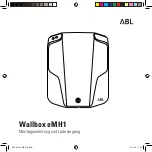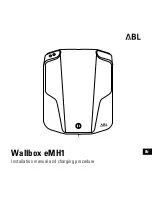
4
EN
1. Safety Instructions
1. To reduce the risk of electrical shock, do not expose this product to
rain, snow, spray, moisture, excessive pollution and condensing
circumstances. To reduce the risk of fire hazards, do not cover or
obstruct the ventilation openings or expose the charger to dusty
environments. Install this product only in a well ventilated room.
2. The installation of this product must be performed by qualified
personnel and in accordance with local electrical regulations.
Make sure to correctly size AC and DC wiring, in order to withstand
the maximum currents that could flow through these wires. Take
care of a solid installation of all wiring and anchor wiring were
possible to add a degree of strain relieve. Never operate this
product when the wiring is undersized or damaged.
3. Except for the connection compartment, this product may never
be opened or disassembled by anyone other than authorized and
trained personnel. There are no user serviceable parts inside this
product.
4. To reduce the risk of electrical shock, disconnect this product from
all AC and DC lines and wait for at least 1 minute, before
performing any maintenance, removing the connection compart-
ment cover, storing or transporting of this product. Switching the
power switch of this product to the off (O) position, will not be
sufficient to reduce the risk of electrical shock since the internal
circuits remain energized.
5. To reduce the risk of electrical shock, this product must be
provided with a permanent safety earth ground connection to the
AC input ground terminal, and/or the external grounding point at
the bottom of this product. Never operate this product when the
AC input ground terminal is not connected or when there is a
chance that the grounding connection might be impaired.
6. To reduce the risk of electrical shock, a Ground Fault Circuit
Interruptor (GFCI) must always be installed in the AC supply circuit.
Make sure this product can be disconnected from the AC supply
circuit by installing an appropriate double pole AC switch.
7. To reduce the risk of explosion, never use this product in locations
where there is danger of gas- or dust explosions or where ignition
protected equipment is mandatory. Never install this product
directly on top of the battery or vice-versa.
8.
Working in the vicinity of lead-acid batteries is dangerous.
Batteries generate explosive gases during normal operation. The-
refore, it is of utmost importance that each time before servicing
this product in the vicinity of the battery, that you read all enclosed
manuals and follow the instructions exactly.
9. Always disconnect the AC supply before making or breaking the
connections to the battery.
10.
This product is intended for charging lead acic pb batteries
(flooded, GEL and AGM batteries) and to supply consumers that
are attached to these batteries in fixed installations. This product
is capable to charge Lithium based batteries as well.
Do not attempt to charge batteries based on other chemistries or
non rechargeable batteries with this charger. This may result in
bursting batteries and can cause personal injuries and other
damage.
11. Always install a correctly sized external DC fuse or circuit breaker
as close as possible to the battery terminals.
•
To reduce the risk of battery explosion, follow these instructions
and those published by the battery manufacturer and the ma-
nufacturer of any unit you intend to use in the vicinity of the
battery. Review cautionary markings on these products.
•
The use of any attachments or spare parts not recommended or
sold by BÜTTNER ELECTRONIK, may result in risk of fire, electric
shock or injury to persons.
•
If this product is protected against reverse polarity by an internal
fuse. This fuse can only be replaced by authorized personnel.
Introduction
Thank you for purchasing a BÜTTNER ELEKTRONIK GmbH Inverter
Charger Combi (ICC). Please read this owner’s manual for information
about using the product correctly and safely. Keep this owner’s manual
and all other included documentation close to the product for future
reference. For the most recent manual revision, please check the
downloads section on our website.
The purpose of this owner’s manual is to provide explanations and
procedures for operating, and configuring the Inverter Charger Combi.
For installing the Inverter Charger Combi, a separate installation guide
is included. The installation guide is intended for installers that should
have knowledge and experience in installing electrical equipment,
knowledge of the applicable installation codes, and awareness of the
hazards involved in performing electrical work and how to reduce
those hazards.
- 15 -
Betriebshinweise:
•
„Netz“-Signalausgang:
An dieser Klemme wird ein 12V Signal geliefert sobald der BCB am Netz angeschlossen ist. Es kann
zu Steuerungs- und Anzeigezwecken genutzt werden. Der Ausgang kann bis zu 0,1A liefern und ist
gegen Kurzschluss und Überlastung geschützt.
•
Ladevorgang unterbrechen:
Der Ladevorgang im Booster-Betrieb wird nach einem Stillstand der Lichtmachine bzw. Entfernen des
Steuersignals „D+“ unterbrochen. Ebenfalls bei Netzbetrieb nach Ausfall der Netzversorgung.
Die angeschlossenen Batterien werden nicht vom BCB entladen. Der Ladevorgang kann auf diese
Weise jederzeit unterbrochen werden.
Bei häufigen Unterbrechungen, speziell vor dem Erreichen der Vollladung (LED „Battery Full“ leuchtet
dauernd), sollte der Batterie jedoch im Netz-Betrieb gelegentlich ein vollständiger Ladezyklus
von
24 Stunden zur Ausgleichsladung gegönnt werden.
•
Batterielebensdauer: Teilentladene Batterien:
Batterien auf Blei-Basis besitzen im Gegensatz zu anderen Batterie-Technologien keinen
schädlichen Memory-Effekt. Daher: Im Zweifel teilentladene Batterien möglichst bald wieder voll
laden.
Nur vollgeladene Batterien lagern, regelmäßig nachladen, besonders bei gebrauchten (älteren)
Batterien und bei höheren Temperaturen.
•
Batterielebensdauer: Tiefentladene Batterien sofort laden:
Einsetzende Sulfatierung der Batterieplatten bei Tiefentladungen durch sofortige Ladung
unterbinden, insbesondere bei niedrigen und hohen Umgebungstemperaturen. Falls die Sulfatierung
noch nicht zu weit fortgeschritten war, kann die Batterie einen Teil der Kapazität nach einigen Lade-
/Entladezyklen wieder zurückerlangen.
•
Batterielebensdauer: Batterien kühl halten, Einbauort entsprechend auswählen.
•
Überspannungsschutz der START-Batterie:
Der BCB schützt sich auf der START-Seite gegen den Anschluss zu hoher Spannungen,
Schaltschwelle 16,5 V, automatische Rückkehr < 16,5 V.
•
Überspannungsschutz der BORD-Batterie:
Der BCB schützt sich auf der BORD-Seite gegen den Anschluss zu hoher Batteriespannungen bzw.
schaltet bei defekten zusätzlichen Ladeanlagen (Solaranlagen, Generatoren o. ä.) ab, Schaltschwelle
15,5 V, Verzögerung 20 s. Rücksetzung durch Batterie < 12,75 V (30 s), entfernen des Steuersignal
„D+/Kl.15“, Netzstecker ziehen.
•
Überspannungsbegrenzung BORD-Batterie:
Zum Schutz empfindlicher Verbraucher ist die Ladespannung auf max. 15,0 V bei allen Ladearten
begrenzt.
•
Überlast- / Überhitzungsschutz BCB:
Der BCB ist gegen Überlastung doppelt elektronisch gesichert und schützt sich selbst gegen widrige
Einbaubedingungen (z. B. schlechte Belüftung, zu hohe Umgebungstemperaturen) durch allmähliche
Abregelung der Ladeleistung.
Batterielebensdauer:
•
Batterien kühl halten, Einbauort entsprechend auswählen.
•
Offene Säurebatterien („wartungsfrei nach EN / DIN“): Regelmäßig Säurestand
prüfen!
•
Tiefentladene Batterien sofort wieder aufladen, teilentladene Batterien gegen
einsetzende Sulfatierung möglichst bald wieder voll laden!
•
Nur vollgeladene Batterien lagern und regelmäßig nachladen, besonders ältere,
gebrauchte Batterien bei höheren Temperaturen! Falls eine Sulfatierung noch nicht zu
weit fortgeschritten war, kann die Batterie einen Teil der Kapazität nach einigen Lade-
/Entladezyklen wieder zurückerlangen.
Warning
Before proceeding with this owner’s manual, please make sure you
have carefully read the enclosed safety flyer and installation guide!
Содержание MT 81660
Страница 2: ...2 EN 3 19 35 Content Inhalt Contenu EN DE FR...
Страница 51: ......





































